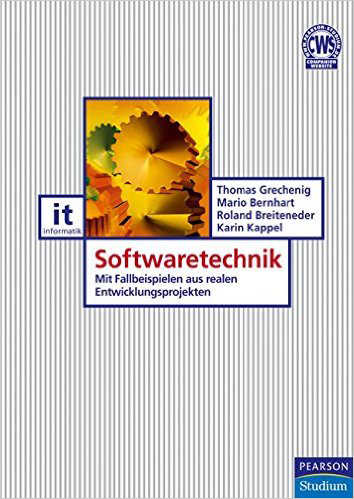Publications
Books
T. Grechenig, M. Bernhart, R. Breiteneder, K. Kappel (Hrg.): “Softwaretechnik. Mit Fallbeispielen aus realen Entwicklungsprojekten”; Pearson Studium, München, Germany, 2009, ISBN: 978-3-8689-4007-7; 688 S.
Software ist ein bemerkenswertes Phänomen unserer Zeit. Ihr Auto, Ihr Büro, Ihr Handy, Ihre Firma, Ihr DVD-Player, Ihre Stadtverwaltung, Ihre Airline: sie alle arbeiten oder funktionieren heute mit Hilfe von Softwaresystemen. Sie alle könnten den gewohnt hohen Grad an Dienstleistung ohne Software gar nicht mehr erfüllen.Wirtschaftlich gesehen wird Software immer mehr zur Grundressource. Sie sprengt die feine Unterscheidung der Wirtschaftswissenschaften zwischen Ware, Gut und Produkt. Software wird zur “Commodity”. Jeder gute Softwaretechniker wird zum Rohstoffproduzenten.
Softwaretechnik ist die Kunst, das Handwerk und die Industrie, diesen teuren Rohstoff zu erzeugen. Softwaretechnik ist aus der Sicht des Fachexperten jene hohe Ingenieurkunst, gute Software in der geplanten Zeit, im Rahmen des vorgesehenen Budgets in einem Team zu planen, zu bauen und zum erfolgreichen Einsatz zu bringen.
Das vorliegende Buch ist eine realitätsnahe Einführung in die Softwaretechnik. Es erläutert, wie man Softwareprojekte methodisch ohne größere Risiken zum Erfolg führt. Es vermittelt das Grundgerüst für den Bau solider Softwaresysteme, liefert eine ausgewogene Gesamtprojektsicht und stellt eine Guideline dar, wie man moderne Software-Entwicklungsprojekte mit den Aufwandsgrößen von 12 Personenmonaten (z.B. ein Web-Shop für regionale Produkte) über 120 (z.B. die betriebliche Verwaltung eines Mittelständers) bis 1200 (z.B. Sparbuch- und Anlageverwaltung einer großen Bank) nach dem technischen State-of-the-Art angemessen ausführt.
Das Buch richtet sich an Studierende der Fachrichtung Informatik, Wirtschaftsinformatik, Medieninformatik, Wirtschaftsingenieurwesen, Maschinenbau, Elektrotechnik sowie Software-Interessierte anderer Studienrichtungen. Das Buch ist auch für Leser nutzbringend, die bereits in der Berufspraxis stehen, angehende Projektleiter oder Teammitglieder in Softwareprojekten sind oder einfach ihr Wissen auffrischen wollen.
Other Publications
M. Bernhart, S. Strobl, A. Mauczka, T. Grechenig: “Applying Continuous Code Reviews in Airport Operations Software”; in: “Proceedings of the 12th International Conference on Quality Software (QSIC), 2012”, A. Tang, H. Muccini (Hrg.); IEEE, (2012), ISBN: 978-1-4673-2857-9; S. 214 - 219.
Code reviews are an integral part of the development of a dependable system such as for airport operations. It is commonly accepted that code reviews are an effective quality assurance technique even if a rigorous application is also a high cost factor. For large software systems a formal method may be inapplicable throughout the whole code base. In this study an airport operational database (AODB) is developed with the application of a more lightweight approach to code reviews. A continuous, distributed and change-based process is applied by the development team and evaluated in comparison to team walkthroughs (IEEE-1028) as a baseline method. The application showed to be highly useful, equally effective as the baseline, but more efficient especially for the preparation, execution and rework effort. The results show that continuous code reviews also support the understanding of the code base and the concept of collective ownership. Such processes may not completely substitute a more formal and effortful technique. Especially for reviewing critical design aspects or complex items a traditional approach is still more appropriate. The main outcome is that such lightweight code reviews may be used together with more formal approaches to ensure a high coverage and that the degree of formalism should be adopted to the criticality of the item under review.
S. Taber, C. Schanes, C. Hlauschek, F. Fankhauser, T. Grechenig: Automated Security Test Approach for SIP-based VoIP Softphones. Second International Conference on Advances in System Testing and Validation Lifecycle (VALID), 2010
Voice over Internet Protocol based systems become more and more part of business critical IT infrastructures. To increase the robustness of voice applications, automated security testing is required to detect security vulnerabilities in an efficient way. In this paper we present a fuzzer framework to detect security vulnerabilities in Voice over Internet Protocol Softphones, which implement Session Initiation Protocol. The presented approach automates the Graphical User Interface interaction for softphones during fuzzing and also observes the behavior of the softphone Graphical User Interfaces to automatically detect application errors. Results of testing two open source softphones by using our fuzzer showed that various unknown vulnerabilities could be identified with the implemented fuzzer and some vulnerabilities were found that are only detectable by using Graphical User Interface observation.
M. Bernhart, T. Artner, A. Mauczka, T. Grechenig: “Automated Integration Testing and Verification of a Secured SOA Infrastructure - an Experience Report in eHealth”; in: “Proceedings of the Twenty-Second International Conference on Software Engineering & Knowledge Engineering”, Knowledge Systems Institute Graduate School, (2010), ISBN: 978-1-891706-26-4; S. 198 - 202.
